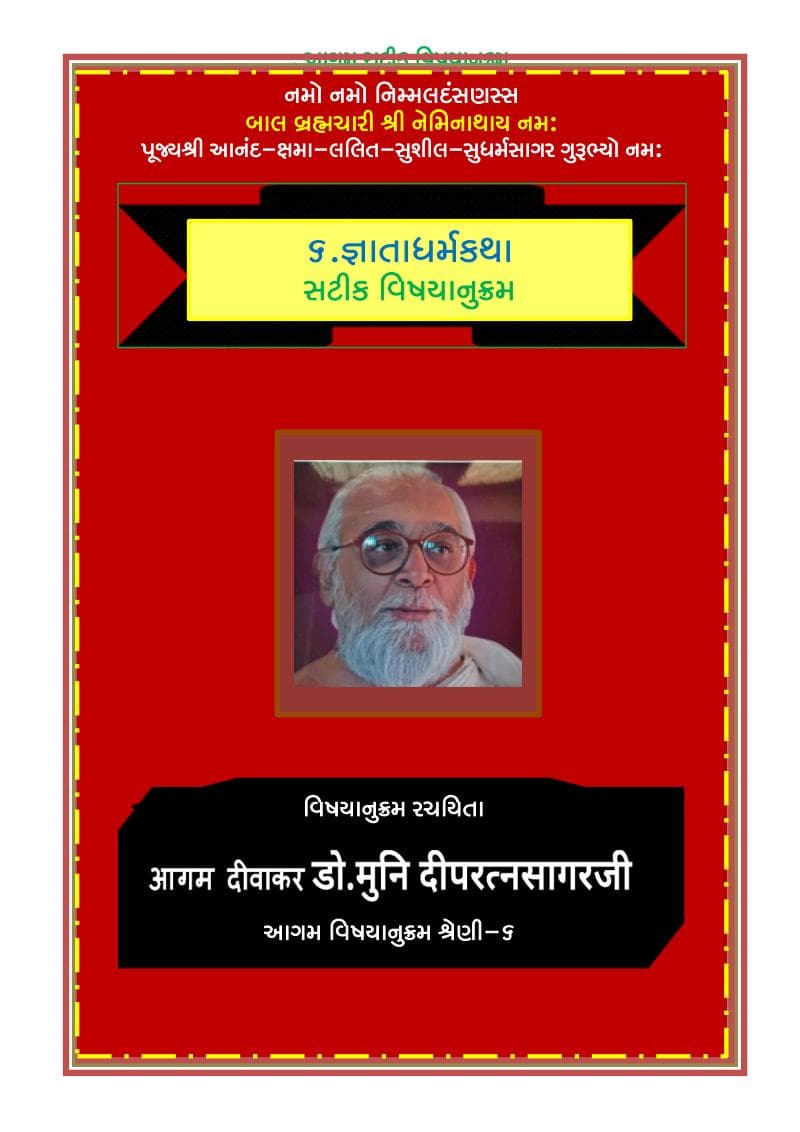06 Gnatadharmkatha Aachar Satik Vishayanukram
Added to library: September 1, 2025

Summary
The provided text, "06 Gnatadharmkatha Aachar Satik Vishayanukram" by Dipratnasagar, Deepratnasagar, published by Dipratnasagar, Deepratnasagar, appears to be a detailed index or thematic guide to the Jain scripture "Gnatadharmkatha" (also known as Jñātṛdharma-kathā).
Based on the title and common Jain textual structures, this work likely serves as a comprehensive summary and analytical breakdown of the Gnatadharmkatha scripture. The term "Vishayanukram" strongly suggests a systematic arrangement of the topics, themes, and contents covered within the original text.
Here's a breakdown of what can be inferred and is typically found in such a work:
-
Focus on Gnatadharmkatha: The core purpose of this book is to illuminate the Gnatadharmkatha. This scripture is one of the fourteen Purvas, considered among the earliest and most important texts in Jainism, particularly within the Agamas (canonical scriptures) of the Shvetambara tradition. It is known for its extensive discussions on ethics, morality, vows, karma, and the conduct of both monks and laypeople.
-
"Aachar Satik" (with commentary): The inclusion of "Aachar Satik" indicates that this work is not just a simple index but is likely accompanied by commentary or explanations. This suggests it might be an index to a specific annotated version of the Gnatadharmkatha, providing insights into the meaning and application of the principles discussed. The commentary would aim to make the complex teachings more accessible to the reader.
-
"Vishayanukram" (Thematic Index/Subject Index): This is the key descriptor. It means the book is structured around the various subjects and themes within the Gnatadharmkatha. This could include:
- Classification of Karma: The text likely details the different types of karma and their effects on the soul.
- Rules of Conduct (Achar): It would cover the specific guidelines for monks (acharyas) and lay followers (shravakas and shravikas) in their daily lives, spiritual practices, and adherence to vows.
- Ethical Principles: The core moral teachings of Jainism, such as non-violence (ahimsa), truthfulness (satya), non-stealing (asteya), celibacy/chastity (brahmacharya), and non-possession/non-attachment (aparigraha) would be prominently featured.
- Discussions on Vows (Vratas): Both the major vows for ascetics and the minor vows for laypeople would likely be analyzed.
- Narratives and Examples: The Gnatadharmkatha is known for its illustrative stories and examples that serve to explain abstract philosophical concepts. The "Vishayanukram" would categorize these narratives by the principle they illustrate.
- Spiritual Development and Liberation (Moksha): The text would likely index discussions related to the path to spiritual liberation and the stages of spiritual progress.
- Social and Lay Conduct: Beyond monastic life, it would cover the ethical responsibilities and practices expected of Jain householders in their interactions and duties.
-
Authorship and Publishing: Dipratnasagar and Deepratnasagar are credited as both authors and publishers, suggesting they are likely scholars, monks, or institutions dedicated to Jain studies and dissemination of its scriptures. Their engagement in producing this work indicates a commitment to making the rich content of the Gnatadharmkatha more organized and understandable.
In essence, "06 Gnatadharmkatha Aachar Satik Vishayanukram" is a scholarly tool designed to provide a structured overview and thematic mapping of the Gnatadharmkatha. It aims to facilitate a deeper understanding of the scriptural content by systematically organizing its principles, rules of conduct, ethical discussions, and illustrative narratives, likely enhanced by accompanying commentary.
For someone wanting to study the Gnatadharmkatha, this index would be invaluable for identifying specific topics of interest, tracing the development of particular doctrines, and accessing the relevant sections of the original scripture with the aid of the commentary.